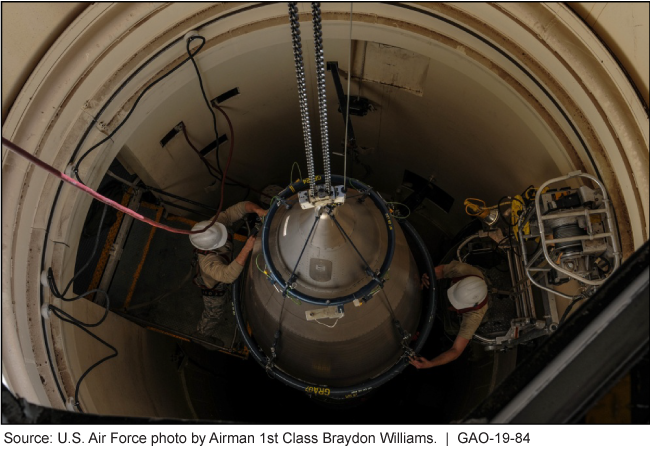Nuclear Weapons: NNSA Has Taken Steps to Prepare to Restart a Program to Replace the W78 Warhead Capability
Fast Facts
The National Nuclear Security Administration is preparing to restart a program to replace the W78 nuclear warhead, which is used in Air Force intercontinental ballistic missiles. The goal is to produce the first W78 replacement warhead in fiscal year 2030. Pending further study, this replacement warhead may also be used in Navy submarine launched ballistic missiles.
NNSA has taken steps in
program management, such as developing a risk management plan
assessing technologies for potential use
coordinating with facilities needed to provide warhead components
U.S. Air Force missile maintainers working on an intercontinental ballistic missile

Photo of U.S. Air Force missile maintainers working on an intercontinental ballistic missile
Highlights
What GAO Found
The Department of Energy's National Nuclear Security Administration (NNSA) has taken steps to prepare to restart a life extension program (LEP) to replace the capabilities of the Air Force's W78 nuclear warhead—a program which was previously suspended. According to NNSA officials, these steps are typically needed to conduct any LEP. Therefore, they can be undertaken despite the current uncertainty about whether the final program will develop the warhead for the Air Force only or for both the Air Force and the Navy. Specifically, NNSA has taken the steps described below:
- Program management. NNSA has begun to establish the program management functions needed to execute a W78 replacement program, as required by NNSA's program execution instruction. For example, NNSA has started to develop a risk management plan to define the process for identifying and mitigating risks. In addition, NNSA has created a preliminary schedule to restart the program in fiscal year 2019 in the feasibility and design options phase with the goal of producing the first unit in fiscal year 2030. (See figure)
- Technology assessment. In May 2018, NNSA completed an assessment of 126 technologies for potential use in a W78 replacement. These included nine technologies that are needed to replace obsolete or no longer available technologies or materials. These are considered “must-do” because they are the only technologies or materials available to meet minimum warhead requirements established by the Department of Defense and NNSA. NNSA officials said that in fiscal year 2019 they will use the assessment to further evaluate technologies for potential use in the warhead.
- Coordination with facilities and capabilities. NNSA's program manager is identifying the facilities and capabilities needed to provide components for the warhead. This information will be used to produce a report that identifies aspects of the program—including facilities and capabilities to support it—that could affect the program's schedule and technical risk. However, several of the needed facilities must be built or repaired, and these activities are separately managed and supported outside the W78 replacement program—representing a critical external risk to the program. As mitigation, the program intends to coordinate with the offices that oversee these facilities to draft agreements that describe the work to be performed and timeframes, among other things.
Preliminary W78 Warhead Replacement Program Restart Schedule Fiscal Year 2019 through 2032, as of July 2018

Why GAO Did This Study
The Department of Defense and NNSA have sought for nearly a decade to replace the capabilities of the aging W78 nuclear warhead used by the U.S. Air Force. NNSA undertakes LEPs to refurbish or replace the capabilities of nuclear weapons components. In fiscal year 2014, NNSA was directed to suspend a program that was evaluating a capability that could replace the W78 and also be used by the U.S. Navy. NNSA's most recent estimate—reported in October 2018—was that the combined program would cost about $10 billion to $15 billion. NNSA has been directed by the 2018 Nuclear Posture Review to restart a program to replace the W78 for the Air Force in fiscal year 2019. The 2018 Nuclear Posture Review also directed NNSA and the Navy to further evaluate whether the Navy could also use the warhead.
Senate report 115-125 included a provision for GAO to review NNSA's progress on the program to replace the W78.
GAO's report describes NNSA's steps in key early planning areas—including program management, technology assessment, and coordination with facilities and capabilities—to prepare to restart a program to replace the W78. GAO reviewed documentation on areas such as program management, technologies, and facilities needed for the program, and interviewed NNSA and DOD officials.
Recommendations
GAO is not making recommendations. NNSA and DOD provided technical comments, which GAO incorporated as appropriate.
